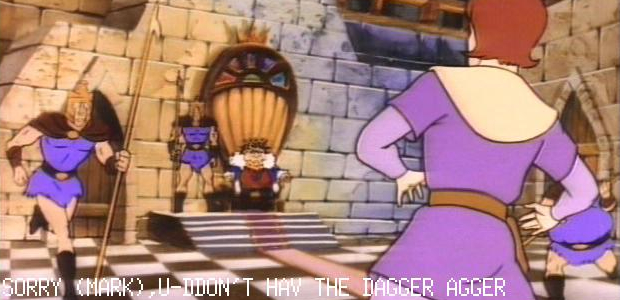Every Wednesday, we highlight rarely-remembered but interesting games for our “Games Time Forgot” series.
Even though the format has long been defunct, a few Laserdisc games have transcended time. Well, okay, one has: Dragon’s Lair. There are plenty of other games made on this format that time has forgotten, but I want to focus on one of them in particular because it took a deviation from the norm, and isn’t recognized for it today. This game, called Thayer’s Quest, was released in 1984, and was made by the same people behind Dragon’s Lair and Space Ace (with the exception of Don Bluth). It was revolutionary for its time, not particularly in its substance (it took the well-tread route of being set in medieval times), but in the way it was made to be played.
Most Laserdisc games forced players to rely on quick reflexes and memorization. In order to not die, one needed to press the right button at a precise moment to move out of harm’s way, attack, or basically make the “movie” move forward. Thayer’s Quest, however, scrapped the normal formula in favor of making the player’s successes based on the decisions they make over the course of the game.
It was the first Laserdisc “RPG” of sorts. It was less of an interactive movie and more of a full-fledged game, full of different places to go, people to talk to, and things to do. But it had its shortcomings. After all, it is a Game Time Forgot.
Story: Thayer’s Quest chronicles the attempts of a young magician’s apprentice to collect five relics from each of the five kingdoms of his world. An evil sorcerer named Sorsabal is also after the relics, with plans to use them to rule over all of the kingdoms. As such, Thayer has to get to each one before Sorsabal can, so he can make sure that their combined power, called the Hand of Quoid, is not abused.
Gameplay: The game was played with a full membrane keyboard, with additional buttons assigned to specific items given throughout the course of the game. The game also used early speech emulation technology to speak to the player. One could type in their name and have the computer speak it back to them over the course of the game. The voice would also give instructions, confirm choices and notify the player of death.

Once the player inputs their name, a short introductory scene plays out. They are given the choice to go into one of two doors; one leads to death, the other to the rest of the opening cinematic. Choices like these are given throughout the game two or three at a time, and you are only given a certain amount of time to choose between them. The numbers 1 through 4 are used to travel or to use items, in certain circumstances. Basically, you move around the world, talk to people to collect information, and use that information to make your decisions wisely. But even if you pay attention, you are probably going to do something wrong and die.
Death comes often in Thayer’s Quest. Unlike other Laserdisc games, where you die because you’re too slow, in this game, you die on a trial and error basis. If you make the wrong decision and go to the wrong place at the wrong time, you will certainly face a gruesome death. Sometimes, you may even know what’s right and still stumble upon an untimely end. The only way to know how to get through the game is to play it hundreds of times, which is the goal of any arcade game, but still; most of the causes of death in Thayer’s Quest are just silly. If you use one of the three magic scrolls you are given in the wrong place, you die. If you try to pluck a flower from the ground, you die. If you go to a pool to heal yourself, you find out at the last moment that the water is actually tainted and die.
Why you’re probably not playing it: Thayer’s Quest was originally a game for the Halcyon, a sophisticated home computer system made by RDI Video Systems. When this system failed to sell, the game was made into a conversion kit for Dragon’s Lair cabinets. But this too was not a very big seller. In all probability, most arcade owners didn’t want to have to convert their successful Dragon’s Lair machines into something new and uncertain.
The few machines that did make it to the arcades didn’t stay there long due to the complaints of parents. It seems that children were very keen on entering swear words into the system to hear the computerized voice say them back. Some parents went so far to claim that some of the pre-programmed phrases also sounded like curses. This caused many arcades to have to ban the game, and the rest was history.
This is just a theory, but I would guess that they probably also complained about all the really horrific death scenes in the game. Because player death was pretty much an inevitability in Thayer’s Quest, small children were being exposed to scenes like these over and over:
I always thought that Dirk’s death animation in Dragon’s Lair was frightening, but if I would have seen this stuff as a kid, I would have had nightmares for weeks. Not only is there skin melting, but also drowning, torture, choking, electrocution, stoning, and being eaten alive by rats. There’s even some blood spurting here and there.
The game doesn’t even tell the complete story when you finally make your way to the end. The official story of the game, which I’ve highlighted above, says that there are five relics to find in all, but Thayer’s Quest only covers the first three. This is because a sequel was supposed to wrap up the story, but it never came. The overall failure of Thayer’s Quest and the Halcyon system forced RDI into filing for bankruptcy.

Though it is largely forgotten, Thayer’s Quest has kind of faintly flickered over the past 25 years. In the early 90’s, the game resurfaced a PC release under the name of Kingdom: The Far Reaches. All of the characters were renamed and additional puzzles were added, but the game still didn’t cover the entire original story. It wasn’t until the PC version’s sequel, Kingdom 2: Shadoan, that the last two kingdoms were visited and the story resolved. This happened 14 years after the release of the original Laserdisc game, under a completely different series name.
It had a lot going against it, but Thayer’s Quest was a very interesting title, and one that I wish I would have encountered in its heyday. It dared to do something different among its Laserdisc brethren and never gets any recognition for doing so, whether or not that may be due to no one having played it in any of its forms. It may not have the amazing animation of Dragon’s Lair, but it’s just as tough to master, and perhaps even more memorably unfair. When it comes down to memorable Laserdisc titles, Thayer’s Quest should be right alongside its older, more famous brothers.





Published: Aug 19, 2009 03:00 pm